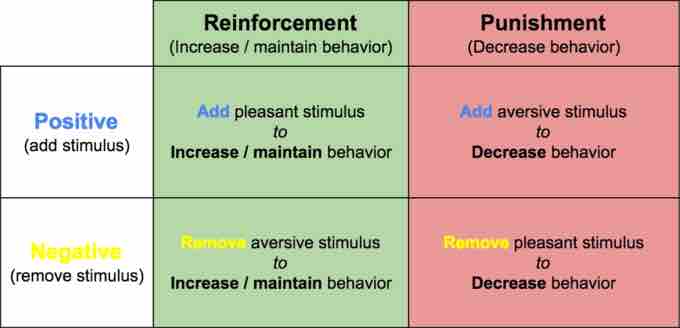Reinforcement and punishment are principles that are used in operant conditioning. Reinforcement means you are increasing a behavior: it is any consequence or outcome that increases the likelihood of a particular behavioral response (and that therefore reinforces the behavior). The strengthening effect on the behavior can manifest in multiple ways, including higher frequency, longer duration, greater magnitude, and short latency of response. Punishment means you are decreasing a behavior: it is any consequence or outcome that decreases the likelihood of a behavioral response.
Extinction, in operant conditioning, refers to when a reinforced behavior is extinguished entirely. This occurs at some point after reinforcement stops; the speed at which this happens depends on the reinforcement schedule, which is discussed in more detail in another section.
Positive and Negative Reinforcement and Punishment
Both reinforcement and punishment can be positive or negative. In operant conditioning, positive and negative do not mean good and bad. Instead, positive means you are adding something and negative means you are taking something away. All of these methods can manipulate the behavior of a subject, but each works in a unique fashion.

Operant conditioning
In the context of operant conditioning, whether you are reinforcing or punishing a behavior, "positive" always means you are adding a stimulus (not necessarily a good one), and "negative" always means you are removing a stimulus (not necessarily a bad one. See the blue text and yellow text above, which represent positive and negative, respectively. Similarly, reinforcement always means you are increasing (or maintaining) the level of a behavior, and punishment always means you are decreasing the level of a behavior. See the green and red backgrounds above, which represent reinforcement and punishment, respectively.
- Positive reinforcers add a wanted or pleasant stimulus to increase or maintain the frequency of a behavior. For example, a child cleans her room and is rewarded with a cookie.
- Negative reinforcers remove an aversive or unpleasant stimulus to increase or maintain the frequency of a behavior. For example, a child cleans her room and is rewarded by not having to wash the dishes that night.
- Positive punishments add an aversive stimulus to decrease a behavior or response. For example, a child refuses to clean her room and so her parents make her wash the dishes for a week.
- Negative punishments remove a pleasant stimulus to decrease a behavior or response. For example, a child refuses to clean her room and so her parents refuse to let her play with her friend that afternoon.
Primary and Secondary Reinforcers
The stimulus used to reinforce a certain behavior can be either primary or secondary. A primary reinforcer, also called an unconditioned reinforcer, is a stimulus that has innate reinforcing qualities. These kinds of reinforcers are not learned. Water, food, sleep, shelter, sex, touch, and pleasure are all examples of primary reinforcers: organisms do not lose their drive for these things. Some primary reinforcers, such as drugs and alcohol, merely mimic the effects of other reinforcers. For most people, jumping into a cool lake on a very hot day would be reinforcing and the cool lake would be innately reinforcing—the water would cool the person off (a physical need), as well as provide pleasure.
A secondary reinforcer, also called a conditioned reinforcer, has no inherent value and only has reinforcing qualities when linked or paired with a primary reinforcer. Before pairing, the secondary reinforcer has no meaningful effect on a subject. Money is one of the best examples of a secondary reinforcer: it is only worth something because you can use it to buy other things—either things that satisfy basic needs (food, water, shelter—all primary reinforcers) or other secondary reinforcers.